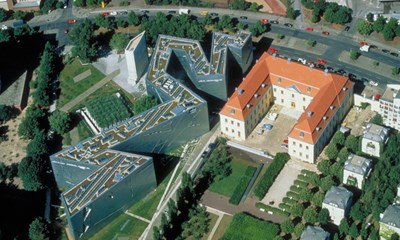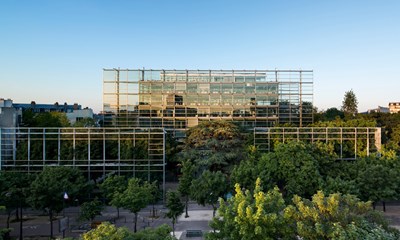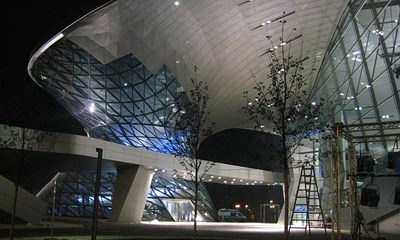Your goals in one place, not all over the place
You are not currently logged in.
If you don't have an account you can create one free and start making your list today!
21 Most Important Works of Contemporary Architecture
The survey asked two questions: Firstly, what are the five most important buildings, bridges, or monuments constructed since 1980? Secondly, what is the greatest work of architecture thus far in the 21st century?
While the range of responses was very broad, more than half of the experts surveyed named the Guggenheim Museum Bilbao by Frank Gehry as one of the most important works since 1980.

1. Visit the Guggenheim Museum Bilbao SPAIN
The Guggenheim Museum Bilbao is a museum of modern and contemporary art, designed by Canadian-American architect Frank Gehry, built by Ferrovial, and located in Bilbao, Basque Country, Spain.
The Guggenheim Museum Bilbao's iconic design by Frank Gehry features a curvaceous titanium exterior that reflects light and creates a constantly changing appearance.

2. Visit the Menil Collection TEXAS
The Renzo Piano-designed museum opened to the public in June 1987 and houses John and Dominique de Menils' privately-assembled collection of twentieth-century art, including over 15,000 paintings, sculptures, prints, drawings, photographs, and rare books.
The Menil Collection in Houston houses over 17,000 artworks spanning various cultures and time periods, including pieces by renowned artists such as Pablo Picasso, Andy Warhol, and Jackson Pollock.

3. Visit the Therme Vals (The Thermal Baths of Vals) SWITZERLAND
Therme Vals is the hotel/spa complex in Vals, built over the only thermal springs in the Graubünden canton in Switzerland. The architect for the project was Peter Zumthor and he received the prestigious Pritzker Architecture Prize in the year 2009.

4. Visit the Hong Kong Shanghai Bank (HSBC) Building HONG KONG
The new building was designed by the British architect Lord Norman Foster and Civil & Structural Engineers Ove Arup & Partners (J. Roger Preston & Partners Engineering) and was constructed by Wimpey International.

5. Visit the Seattle Central Library WASHINGTON
The architects conceived the new Central Library building as a celebration of books, deciding after some research that despite the arrival of the 21st century and the "digital age," people still respond to books printed on paper.
The Seattle Central Library features a unique glass and steel design, resembling a stack of books, and is renowned for its innovative architecture.

6. Visit the Sendai Mediatheque JAPAN
The Sendai Mediatheque is a 21st century style complex designed to learn and enjoy through the media facilities such as a library, a gallery and a studio.

7. Visit the Neue Staatsgalerie GERMANY
The Neue Staatsgalerie in Stuttgart, Germany was designed by the British firm James Stirling, Michael Wilford and Associates, although largely accredited solely to partner James Stirling. It was constructed in the 1970s and opened to the public in 1984.

8. Visit Church of the Light JAPAN
Church of the light (sometimes called "Church with Light") is the Ibaraki Kasugaoka Church's main chapel. This building is one of the most famous designs of Japanese architect Tadao Ando.

9. Visit the Vietnam Veterans Memorial in Washington, D.C WASHINGTON, D.C.
The memorial is maintained by the U.S. National Park Service, and receives around 3 million visitors each year. The Memorial Wall was designed by American architect Maya Lin. The typesetting of the original 58,195 names on the wall was performed by Datalantic in Atlanta, Georgia.
The Vietnam Veterans Memorial in DC is unique in that it is a black granite wall that reflects the viewer's image, symbolizing the connection between the living and the fallen soldiers.
ALSO ON DAY ZERO...
Get inspired with these ideas for interesting and different experiences around the world.
Take your goal setting to the next level with a whole set of exclusive features that will empower you to achieve more.

10. Visit the Millau Viaduct FRANCE
Designed by the French structural engineer Michel Virlogeux and British architect Norman Foster, it is the tallest bridge in the world with one mast's summit at 343.0 metres (1,125 ft) above the base of the structure, with the second highest clearance from the deck to the ground, after Mexico's Baluarte Bridge.

11. Visit the Jewish Museum Berlin GERMANY
The Jewish Museum Berlin, in Berlin, Germany, covers two millennia of German Jewish history. It consists of two buildings. One is the old Kollegienhaus, a former courthouse, built in the 18th century. The other, a new addition specifically built for the museum, designed by world-renowned architect Daniel Libeskind.
The Jewish Museum Berlin's iconic building was designed by architect Daniel Libeskind, featuring a unique zigzag shape that symbolizes the fractured history of German-Jewish relations.

12. Visit the Lloyd's building in London LONDON
The Lloyd's building (also sometimes known as the Inside-Out Building) is the home of the insurance institution Lloyd's of London and was designed by architect Richard Rogers and built between 1978 and 1986.

13. Visit Beijing National Stadium CHINA
Beijing National Stadium, also known officially as the National Stadium, or colloquially as the Bird's Nest, is a stadium in Beijing, China. The stadium was designed for use throughout the 2008 Summer Olympics and Paralympics.

14. Visit the CCTV building in Beijing CHINA
The CCTV Headquarters is a 234 m (768 ft), 44-storey skyscraper in the Beijing Central Business District (CBD) and serves as headquarters for China Central Television (CCTV).

15. Visit the Fondation Cartier PARIS
The foundation was created in 1984 by the Cartier SA firm as a center for contemporary art that presents exhibits by established artists, offers young artists a chance to debut, and incorporates works into its collection. In 1994 it moved to its current location in a building designed by architect Jean Nouvel with garden landscaping by Lothar Baumgarten.
The Fondation Cartier in Paris is known for its stunning glass façade designed by architect Jean Nouvel.

16. Visit BMW Welt GERMANY
BMW Welt (BMW World), is a multi-functional customer experience and exhibition facility of the BMW AG, located in Munich, Germany. In direct proximity to the BMW Headquarters and the Olympiapark, it is designed to present the current products of BMW, be a distribution center for BMW cars, and offer an event forum and a conference center.
BMW Welt in Germany is not only a car showroom, but also a multi-functional exhibition and event venue that attracts over 3 million visitors annually.

17. Visit the Nelson-Atkins Museum of Art MISSOURI
In 1993, the museum began to consider the first expansion plans since the completion of the unfinished areas in the 1940s. Plans called for a 55 percent increase in space and were finalized in 1999. Architect Steven Holl won an international competition in 1999 for the design of the addition. Holl's concept was to build five glass towers to the east of the original building which he calls lenses.
The Nelson-Atkins Museum of Art in Kansas City is home to one of the largest collections of Asian art in the United States.

18. Visit the Cooper Union NEW YORK
In contrast to the Foundation Building, 41 Cooper Square is of modern, environmentally "green" design, housing nine above-ground floors and two basements.
The Cooper Union in New York City was the first institution of higher learning in the United States to offer free tuition to all of its students.

19. Visit the Parc de la Villette PARIS
The park was designed by Bernard Tschumi, a French architect of Swiss origin, who built it from 1984 to 1987 on the site of the huge Parisian abattoirs (slaughterhouses) and the national wholesale meat market, as part of an urban redevelopment project.

20. Visit the Yokohama Port Terminal JAPAN
The Yokohama International Port Terminal is a location of complex movement and interchange between visitors to Yokohama and its inhabitants, between differing modes of transportation, and between both urban and aquatic landscapes.

21. Visit Saint-Pierre, Firminy FRANCE
Designed to be a church in the model city of Firminy Vert, the construction of Saint-Pierre was begun in 1971, six years after Le Corbusier's death in 1965.
ALSO ON DAY ZERO...
Get inspired with these ideas for interesting and different experiences around the world.
Take your goal setting to the next level with a whole set of exclusive features that will empower you to achieve more.
OTHER FEATURE LISTS

Discover the breathtaking beauty of the world with Harper's Bazaar's curated list of the 50 most stunning destinations on the planet.

Embark on a literary journey through the 100 greatest novels of all time, as curated by The Modern Library's prestigious list.

Discover the ultimate European bucket list with our comprehensive guide to the top 50 must-see attractions, activities, and experiences that every traveler should add to their itinerary

Tired of aimless wandering? We've got you covered with a list of 33 popular long-term goals for personal growth, career advancement, and making a difference in the world.

Discovering your purpose is a lifelong journey, and this list of 25 goals will guide you towards clarity, fulfillment, and a deeper sense of meaning in life.

Discover endless possibilities for outdoor entertainment with these 50 fun things to do in your garden or backyard.

Explore the breathtaking beauty and diverse wildlife of 30 of the world's best national parks, from the majestic Yellowstone in the United States to the surreal Torres del Paine in Chile.

Whether you're a new couple looking for fun activities to do together or a long-term couple wanting to spice things up, this list has got you covered. From adventurous outdoor outings to cozy nights in, there's something for every couple to enjoy.

Get ready for a thrilling adventure as we count down the Top 25 most visited amusement parks in the world!

From iconic skyscrapers to cultural landmarks, the American Institute of Architects has released its list of the top 150 buildings in the United States. Check out the full list to see which buildings made the cut.

Discover 50 one-of-a-kind experiences that can only be found in the UK, from historic landmarks to hidden gems.



